India’s NOVEMBER 2020 Festivities
The November festivals of India are the other versions of the foundation of faith; faith in the religious harmony and faith in the prosperous future of the nation as manifested by its children. November is an excellent month to visit India as the weather starts becoming cooler and dryer. Here’s the best of what’s on in November in India . . .
KARVA CHAUTH
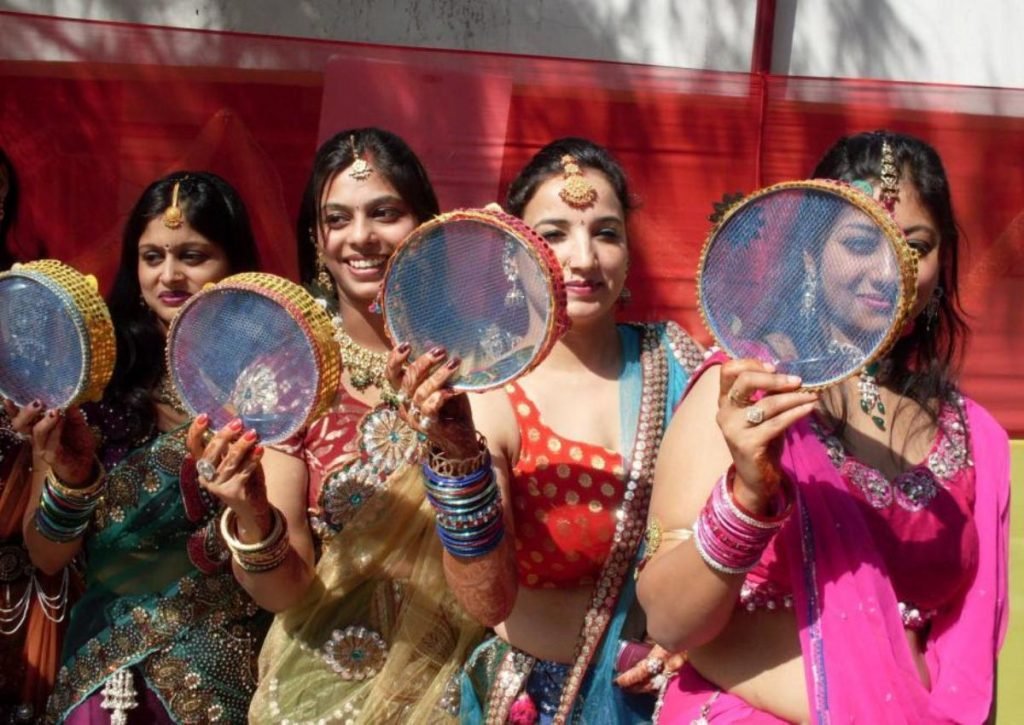
Karva Chauth Vrat (fast) falls on the 4th day of Krishna Paksh in the month of the Karthik. The fast of Karva Chauth is kept by Hindu women for the well-being, prosperity and longevity of their husbands. The origin of this festival is based upon a very sweet and noble idea. In earlier times, girls would get married at a very young age and had to go and live with their in-laws in other villages far away from their own parents. If she had any problems with her husband or in-laws, she would have no one to talk or seek support from. Thus, there grew a custom where the bride would befriend another woman to share her joys and sorrows. Their friendship would be sanctified through a small Hindu ceremony right during the marriage. Once the bride and the woman became god-friends or god-sisters as they are commonly known, they would remain so all their lives and recognize the relation as such. They would also treat each other like real sisters. After becoming friends, they would share all their joys, sorrows and problems with each other. Thus, Karva Chauth started as a festival to celebrate this friendship (relationship) between the brides and their god-friends (god-sisters). Praying and fasting for the sake of husband came later and was secondary. It was probably added, along with other mythical tales, to enhance the festival. In any case, the husband would always be associated with this festival, because the day of startling this holy friendship between two god-sisters was essentially the day of bride’s marriage to him. Thus, praying and fasting for him by his wife during the celebration of her relationship with the god-friend would be quite logical.
CHILDREN’S DAY
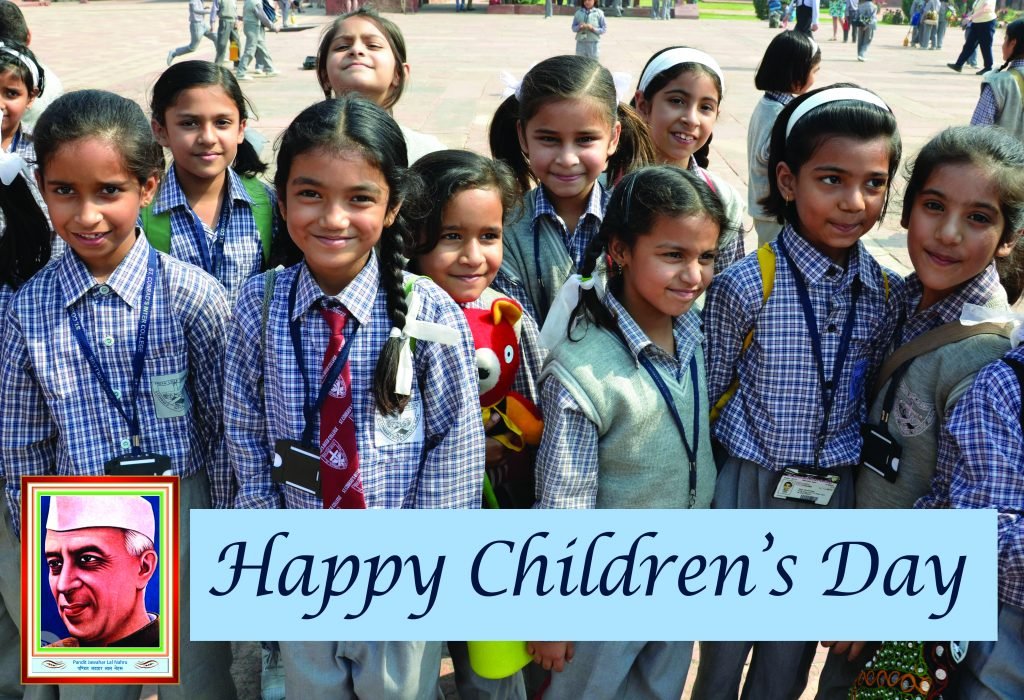
Children’s day is a special day for the children. Universally, Children’s Day is celebrated on 20th November, every year as declared by the United Nations in 1954. But in India it is celebrated on 14th November, because the date marks the birth anniversary of legendary freedom fighter and independent India’s first Prime Minister – Pandit Jawaharlal Nehru. As a tribute to Nehru and his love for children, Children’s Day is celebrated on his birth date. This day reminds to each and every one of us, to renew our commitment to the welfare of children and teach them to live by their Chacha Nehru’s quality and dream. For children, it is a day of much fun and fanfare. On this day, various departments of government announce various schemes and organize various competitions and events for the children. Most schools have cultural programmes for the day. All over the country, various cultural, social and even corporate institutions conduct competitions for children. Children celebrate the day with singing, dancing and storytelling in schools and colleges. This day parent and teachers send cards to their children.
DHANTERAS

Dhanteras is celebrated by Hindus all over India and across the world. It marks the beginning of the five day celebrations of Diwali. It takes place two days before Diwali to honour Dhanvantari an incarnation of Vishnu. Dhantrayodashi “Dhan” means wealth and “Teras” means 13th day. Dhanter¬as is celebrated on the thirteenth lunar day of Krishna Paksha (dark fortnight) in the Vikram Samvat Hindu calendar month of Karthik. Dhanvantari, who is also worshipped on the occasion of Dhanteras, is the god of Ayurveda who imparted the wisdom of Ayurve¬da for the betterment of mankind and to help rid it of the suffering of dis¬ease. On this day, people pray for good health and wealth for the family. Dhanteras is especially a very signifi¬cant festival for the business commu¬nity. People purchase machinery and metals like iron, gold, brass, silver and copper as it is believed that if you obtain “dhan” or wealth on this day, it will make the Goddess of Wealth Lakshmi happy and she will visit your home which will bring prosperity and wealth for rest of the year. Houses are cleaned thoroughly and decorated to look beautiful and welcoming. People make rangoli and light clay lamps to welcome Goddess Lakshmi.
DIWALI
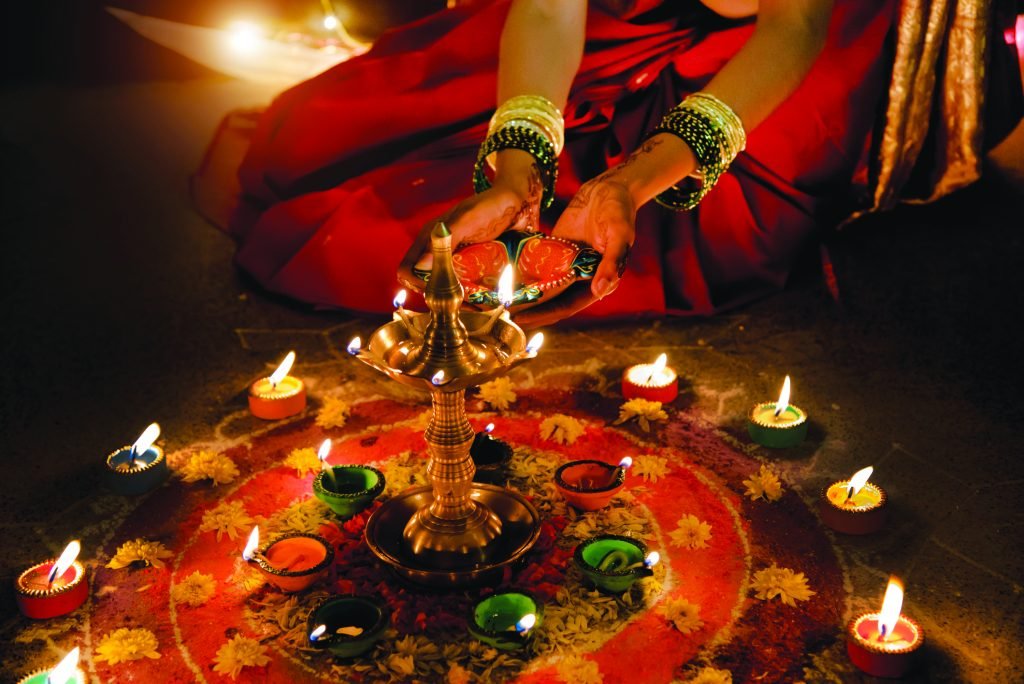
Diwali is one of the most important, hugely waited and immensely cher¬ished festival celebrated across India. Originally, the name was Deepawali, which has its origin from Sanskrit, meaning ‘Rows of Deep’. Popularly known as the ‘Festival of Lights’, Di¬wali is celebrated with great gusto and is observed as an official holiday across India. The festival of Diwali is not only significant to Hindus, but, has importance in Jainism, Buddhism and Sikhism. For Hindus, it is associated with the return of Lord Rama to Ayod¬hya with rows of the deep, lightened throughout the kingdom. Thus, there is a tradition of lighting oil lamps that symbolize the victory of good over evil and freedom from spiritual darkness. Hindus, also make preparations to welcome goddess Lakshmi by draw¬ing Rangoli and Paduka (footsteps) on the entrance that would allure god¬dess Lakshmi to visit one’s home and bring prosperity along with her. There are numerous customs and tradi¬tions associated with Diwali, namely, burning of crackers, lighting of lamps, wearing new clothes, distribution of sweets and exchange of gifts.
KALI PUJA

While the rest of India celebrates Di¬wali, the Bengali community keeps it¬self busy with Kali puja, also known as Dipanwita Kali Puja. Though Goddess Kali is worshipped on other new moon days of the year, as well, but the com¬munity observes this Kali puja on the new moon day of the month of Kar¬tika. For them, this is the annual Kali puja celebration. She is worshipped at night and tantric rites and mantras are followed. She is usually offered animal blood in a skull, rice and len¬tils, sweets, fish and meat and red hibiscus flowers. Homes and pandals may also practice rites in the brah¬manical tradition with ritual dressing of kali as Adya Shakti Kali.
GOVARDHAN PUJA

Govardhan Puja is also known as the Annakut puja meaning a pile of grains. It is celebrated to commemo¬rate the lifting of Mount Govardhan by Lord Krishna. According to a legend in Vishnu Puran, before Lord Krishna was born, Lord Indra, the god of rain, was the chief deity of Vraj. Lord Krish¬na instigated the people to stop wor¬shiping Indra. Indra wanted to prove his power over Krishna so he brought about a cloud – burst which flooded the area for many days. People were afraid that the downpour was a re¬sult of Lord Indra’s wrath. That was when Krishna came forward and lifted Mount Govardhan as an umbrella on the little finger of his right hand so that everyone could take shelter from the rain. It is because of this incident that he got the epithet Govardhandhari.
BHAI DOOJ
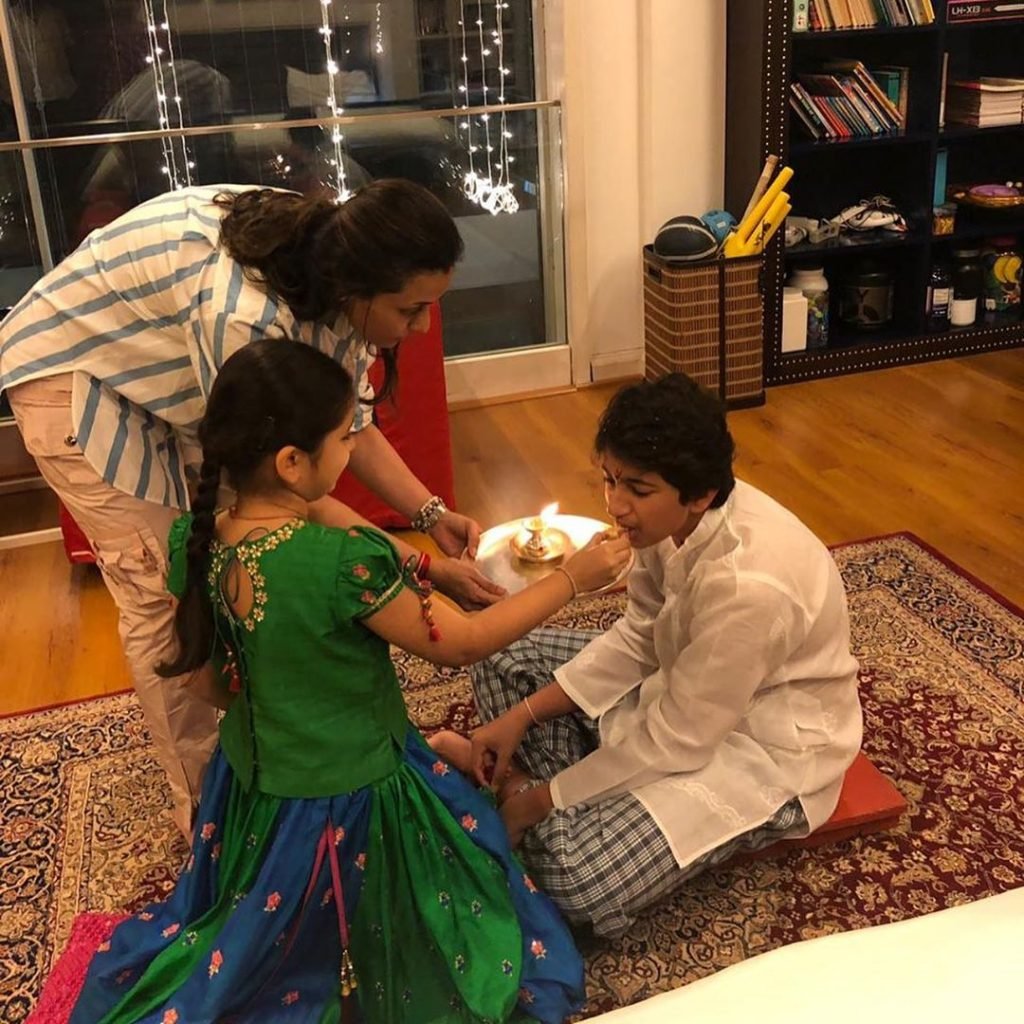
This festival is celebrated on the second day of Shukla Paksh in the month of Karthik. Bhai Dooj normally falls two days before Diwali. On the day of the festival, sisters invite their brothers for a sumptuous meal often including their favorite dishes/sweets. The procedure may be different in Bi-har and central India. The whole cere¬mony signifies the duty of a brother to protect his sister, as well as a sister’s blessings for her brother. Carrying for¬ward the ceremony in traditional style, sisters perform aarti for their brother and apply a red tika on the brother’s forehead. This tika ceremony on the occasion of Bhai Bij signifies the sister’s sincerest prayers for the long and happy life of her brother and treat them with gifts. In return, brothers bless their sisters and may treat them also with gifts or cash. The sister whose brother lives far away from her and can’t go to her house, sends her sincerest prayers for the long and happy life of her brother through the moon god. This is the reason why children of Hindu parents affectionately call the moon Chandamama (Chanda means Moon & Mama means maternal Uncle).
CHHATH POOJA

Chhath also known as Dala Chhath is an important festival celebrated in Bihar and Uttar Pradesh and many other parts of India in which setting sun (dusk) is worshiped. Although Bihar celebrates Chhath most elaborately it is also followed in some parts of West Bengal, Jharkhand, Orissa, Assam and also Mauritius, mainly among the Bhojpuri and Maithali speaking people. Chhath is also important for Nepalese worshipers of god as well as eastern Uttar Pradesh. The best place to witness Chhath would be around Northern Bihar where it is celebrated in great grandeur. The festival is observed since time immemorial with the constant faith that the Sun God fulfills wishes if ‘araghya’ is offered with complete dedicaton and devotion. Along with the Sun God people worship Chhati Maiya on this day. It is a festival connected with purity, devotion to the Sun God who is considered as the source of life on this earth and is regarded as the deity who fulfills all our wishes. In the evening araghya people express their thanks to Sun God for its work in growing their crops during the preceding year and morning araghya is considered as a request for a bountiful crop, peace and prosperity in the year to come. Devotees assemble at the ghats at rivers and ponds including Ganges and take a holy dip before preparing offerings (Prasad). The main constituent at the offerings are Thekua, which is a wheat based cake. Offerings are preferably cooked on earthen chulha. Some traditions are exercised with little difference varying from region to region and across the families with basic similarity. Chhath is a Hindu festival but many Muslim families also participates in this holy festival.
GURU NANAK JAYANTI
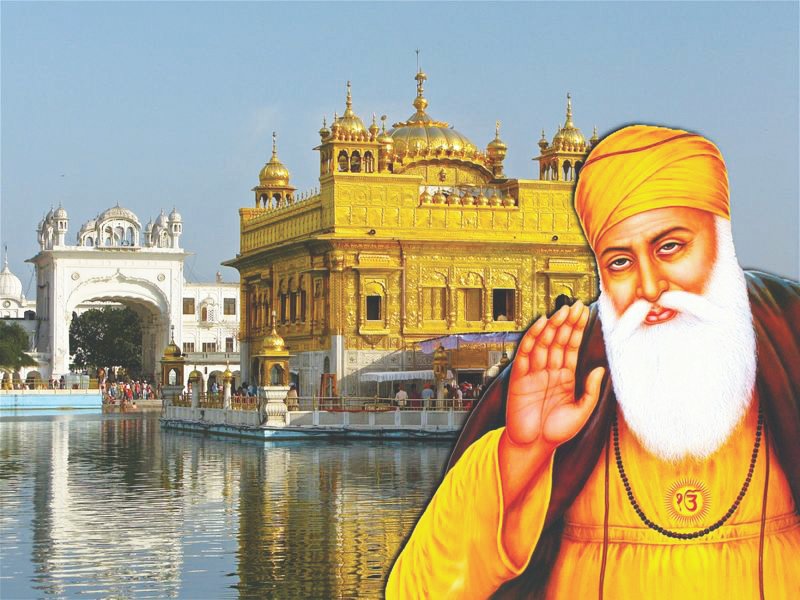
Guru Nanak Dev, the founder of the Sikh faith was born in 1469 A.D. in the village of Talwandi in Lahore, Pakistan. Guru Nanak Dev Jayanti marks the birth anniversary of the founder of the Sikh religion. Guru Nanak Jayanti is marked by prabhat pheris or early morning processions that begins from the Gurudwaras and then moves to different localities singing hymns or shabads. Usually two days before the birthday of Guru Nanak, ‘Akhand Path’ or forty eight hour non-stop reading of the holy book of the Sikhs, Guru Granth Sahib is carried on at the Gurudwaras. A procession is carried out on the day before his birthday which is led by the Panj Pyaras (five beloved ones). Sikh flag, or the Nishan Sahib and the Palki (palanquin) of Sri Guru Granth Sahib are taken out in the procession. The procession also includes a group of singers singing hymns in praise of Guru Nanak and Gatka teams displaying their showmanship through martial arts. The langar (special community lunch) along with ‘Karah Prasad’ is offered to men and women of all communities at the Gurudwaras.

